#c: telos
Explore tagged Tumblr posts
Text

Joker Out Masterpost for new fans
New fan of Joker Out? Say no more!
Getting to know a new artist you’ve found can be intimidating if it’s all in another language, so we’ve compiled some of our favourite interviews, articles and lore here! You’ve arrived in a wonderful fanbase, welcome from all of us here at JokerOutSubs!
If you’d just like a short overview of the band and their history, you can watch this excellent Finnish summary of them that we’ve translated (14m 53s).
youtube
But if you want to dive into the details, then check out our timeline, full of videos and articles translated by JokerOutSubs!
Timeline graphic:
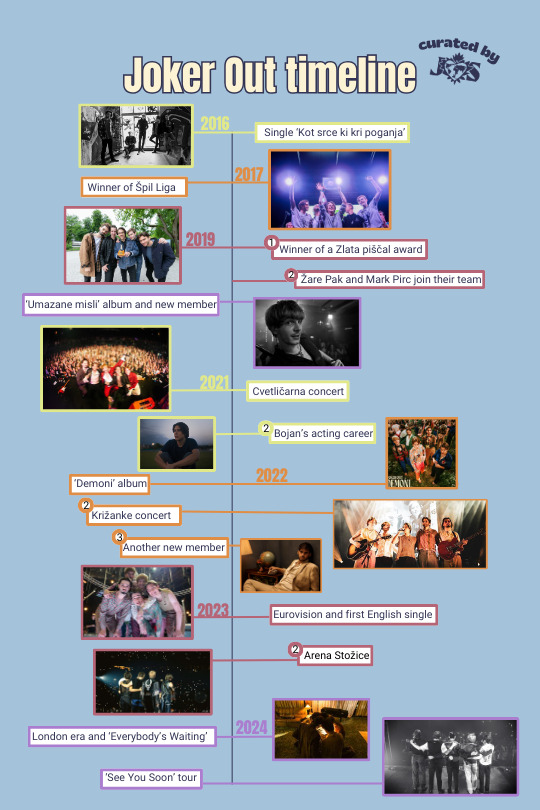
Timeline in details below the cut 👇
Timeline in details:
How did the band form?
Joker Out was formed from two bands, Apokalipsa and Buržuazija.
Apokalipsa included Bojan Cvjetićanin (vocals), Martin Jurkovič (bass) and Matic Kovačič (drums)
They gained some traction with young people around Slovenia, particularly with their song 'Mogoče' ('Maybe'), which you can watch on YouTube here.
They came to the attention of Kris Guštin, who was inspired to start learning guitar! He discusses the details in this video (at 9:40).
Kris then met Jan Peteh, another student of his guitar teacher, and at their teachers advice, they formed the band Buržuazija.
Bojan attended their second ever gig in 2016, and decided these two excellent guitarists were exactly what had been missing from Apokalipsa, as he wasn’t happy with their current guitarists. He asked them to join, and they accepted
The new lineup (Bojan, Jan, Kris, Martin and Matic) decided to rename themselves Joker Out. The name means nothing, but they thought it sounded good and was the ‘least horrible’ of all the ideas they could think of.
So, in 2016, Joker Out was officially formed!
November 2016, Kot srce ki kri poganja:
Joker Out’s first music video was for their song ‘Kot srce ki kri poganja’ ('Like a heart that pumps blood'), filmed in Jan’s hometown of Vrhnika! We eventually got this song on Spotify on their 2023 album Live from Arena Stožice!
Music video: Kot srce ki kri poganja
English Interview (from 3:37 to 6:05): Joker Out discusses filming the music video
June 2017, Špil Liga:
One of the earliest performances for Joker Out was at Špil Liga, a competition for young bands in Slovenia. They won, and recorded their winning song, Omamljeno telo (intoxicated body) in November as part of the prize.
Live (33m): Joker Out at Špil liga
Interview (5m): Reflections on Špil Liga in 2023
c.2017/18, Bojan’s attempt at going solo:
The band took a hiatus c.2017/18, and Bojan considered going solo at that time, even working with a few producers. He eventually realised that he belonged with the band! Hear him tell the story:
Reel (1m 23s): A1 Vajb - Bojan’s fail
2019, A change up for the band:
The band began working with their current producer, Žare Pak, and their videographer Mark Pirc, in 2019 - both of whom have been referred to as the sixth member of the band. This led to a change in their sound and production quality, which culminated in ‘Gola’ ('Naked'), the first of their songs to be a big hit!
Music video: Gola
Zlata piščal ('Golden Flute') - Best New Artist 2019:
Joker Out won their first Zlata piščal award in 2019, for best new artist (one of many they’d go on to win!) This is a kind of Slovenian Grammy! Covid interrupted the proceedings, but you can see their interview for it here (3m 59s)-
Interview: Joker Out wins a Zlata piščal ('Golden Flute') for Best New Artist 2019
Umazane misli, and a new member:
During the Covid times, the band began recording their first studio album, 'Umazane misli' ('Dirty thoughts'), which was originally going to be released in March 2020 but was repeatedly delayed until October 2021. The first half was recorded with drummer Matic Kovačič, but the band felt they needed something extra and brought in Jure Maček to help write the arrangements. They loved him so much, he never left!
Interview (from 10:40 to 11:36): Bojan talks briefly about Jure joining the band
COVID times, and Cvetličarna:
The band had arranged to do two concerts at Cvetličarna, a very important venue in Slovenia and a big break for them. This was delayed several times due to Covid, but eventually managed to go ahead in October 2021 for the release of their first album.
Video (1m 14s): Cvetličarna promotional video
Live (1h 28m): Joker Out at Cvetličarna
Interview (34m 55s): Bojan discusses Cvetličarna, its importance, and Covid
Umazane misli album launch:
'Umazane misli' was extremely well received! The band would go on to win two more Zlata piščal awards, Newcomers of the Year in 2020 and Artist of the Year in 2021.
Interview (37m 08s): Umazane misli album presentation
An acting career for Bojan?
Around the same time as 'Umazane misli' was released, Bojan began considering an acting career. He acted in two episodes of the series ‘Gospod Professor’ and in another series, which was eventually reworked as a film called ‘Kaj pa Ester’ and released in December 2023. He decided music was his passion though, and he wanted to fully focus on that.
Interview (from 10:04 to 11:30): Bojan discusses his acting career
Interview (2m 11s): Kaj pa Ester interview
Interview (2m 30s): Kaj pa Ester première
Article: Bojan on Kaj pa Ester
September 2022, Križanke:
The band got straight to work writing their second album, 'Demoni' ('Demons'), and decided to present it in September 2022 at Križanke, another hugely important venue in Slovenia. This whole concert wasn’t recorded, but we have an interesting advertisement they did for it, an interview and a clip of one song live from Križanke!
Video (5m 4s): Full Joker Out Hotline trailers
Interview (2m 16s): Joker Out with parachutes to Križanke?
Live (4m 7s): 'Novi val' ('New wave') live at Križanke
Interview (44m 35s): Demoni album presentation
Another new member!
After Križanke at the end of 2022, Martin Jurkovič, one of the founding members of the band, made the decision to leave to focus on his studies.
Video (2m 20s): Martin's departure
Thankfully, he was replaced by the wonderful Nace Jordan, who remains the bassist in the current lineup.
Article: Nace Jordan discusses joining the band
2023, Eurovision:
Joker Out were then internally selected to go to Eurovision 2023, and began recording their Eurovision song, 'Carpe Diem', in Hamburg in December 2022. To learn more, you can watch the Carpe Diem series, a documentary series which followed their entire journey.
The first episode, recording Carpe Diem, can be found with subtitles in multiple languages by JokerOutSubs!
Video (16m 41s): Carpe Diem Ep. 1 - Hamburg
The band performed their song for the first time live on Misija Liverpool, a televised debut, on the 4th February 2023.
Video (27m): Joker Out performing at Misija Liverpool
There are quite literally hundreds of interviews with Joker Out during the Eurovision era. Here's one from just before the final, that we have translated.
Interview: Joker Out before the final on the 13th May
And a few English interviews that became famous in the fanbase!
Interview (24m 29s): Eurovanja
Interview (8m 10s): Seize the Day situations
Interview (17m 18s): Tiktok Live
Interview (6m 30s): ‘Never have I ever’
Interview (14m 12s): Madrid Eurovision
Result
Joker Out came 21st at Eurovision, which they were satisfied with.
Interview (1m 36s): Bojan talks about their results
European tour and Sunny Side of London (22nd September)
Luckily, the best was still to come for Joker Out! The rest of 2023 was spent on an extremely successful European tour, and they also released their first English single, 'Sunny Side of London', in September.
We at JokerOutSubs were also thrilled to interview the band twice on their tour!
Original Interview (15m 25s): JokerOutSubs interview in Tampere
Original Interview (14m 37s): JokerOutSubs interview in Poznań
6th of October 2023, Stožice:
All of this, however, was building up to Stožice. This is the biggest closed venue in Slovenia and Joker Out managed to sell out their October show there - an extremely important milestone for Slovenian artists.
Interview (15m 4s): Stožice and their whirlwind post Eurovision career
Live: Full concert live-streamed part 1 and part 2
A lovely moment at Stožice was when former members Martin Jurkovič and Matic Kovačič joined the band onstage to perform 'Kot srce ki kri poganja'!
Interview (2m 4s): Martin and Matic discuss the experience
Interview (5m 9s): Joker Out post Stožice impressions
London era and Everybody’s Waiting:
Joker Out spent the beginning of 2024 in London, where they wrote new music, did live cooking shows on Instagram and met the incredibly talented photographer, Damon Baker, who did a beautiful series of photoshoots with them. They also released their next English single, 'Everybody’s Waiting', in February.
They sat down with us at JokerOutSubs to discuss all this on the 20th February!
Original Interview (59m 13s): JokerOutSubs interview in London
March and April 2024, ‘See you soon’ tour:
The boys then embarked on the ‘See you Soon’ tour, another very successful European tour. They played three new songs live during the tour, two of which we translated from the concert videos of our members!
Live: First performance of 'Bluza' ('Blouse')
Live: First performance of the hugely popular 'Šta bih ja' ('What would I')
We at JokerOutSubs also interviewed the band a fourth time in Padova!
Original Interview (22m 7s): JokerOutSubs interview in Padova
Now you know a little bit about Joker Out’s history, let’s look a little bit at the members of the band as individuals!
Who are the members?
Bojan Cvjetićanin - singer

Charming, charismatic and an all round green flag, deep down we’re all Bojan girlies! See him here on Cosmopolitan's Blind date, Portrait with Coffee and a lovely interview he did for Delo!
Interview (8m 49s): Cosmopolitan's Blind date
Interview (18m 3s): Portrait with Coffee
Article: “If we believed that we were “kings”, that wouldn’t be us”
Jan Peteh - guitarist

The mysterious mathematician of the band, Jan and his cat Igor have stolen the hearts of the fanbase. Here he is on Undercover Mathematician and on Metropolitan podcast with ex bassist Martin!
Interview (3m 26s): Undercover mathematician
Interview (43m 57s): Jan and Martin on Metropolitan podcast
Kris Guštin - guitarist

Known for his organisational expertise, 'slay pose' and 'cake baking skills,' Kris stays fabulous on and off stage!
Video (1m 5s): NGVOT backstory (Kris’ breakup) at Cvetličarna
Article: Interview with the entire Guštin family
Jure Maček - drummer

Described consistently by his band mates as ‘čaga’ (party), Jure brings a chaotic energy to Joker Out that we love to see!
Video (41s): Jure’s cheating (in school!) story
Interview (18m 3s): Sunday Chat on Radio 94
Nace Jordan - bassist

The oldest member of Joker Out, Nace is a genuine sweetheart who fit like a glove into Joker Out despite joining much later!
Article: "Enriched by a special [Eurovision] experience"
Interview (18m 24s): Interview with JokerOutSubs in Umag
Get to know the whole band!
They mostly do interviews together, so here are some of our favourites!
Interview (16m 52s): Vičstock Unplugged
Video (7m 3s): Joker Out pre-Križanke Instagram Q&A compilation
Interview (54m 42s): Multisciplinary panel at Bežigrad High School
Article: Joker Out for DELO
Article: Joker Out for Mladina magazine
Interview (6m 42s): Joker Out for RTV SLO
Interview (1h 1m): Joker Out for N1 podkast
We hope you’ve enjoyed learning a bit more about our favourite band!
If you’d like even MORE translated interviews, articles and Instagram stories, you can find us on Tumblr, X, Facebook, Instagram, TikTok, YouTube and Spotify under the name JokerOutSubs!

P.S: If you wish to share this post with new fans, we also provided QR codes!


#joker out#jokeroutsubs#bojan cvjetićanin#bojan cvjeticanin#jan peteh#kris guštin#nace jordan#kris gustin#jure macek#joker out band#jure maček#jos: masterpost#event: stožice#event: križanke#event: eurovision#event: kaj pa ester#jos: announcement#year: 2016#year: 2017#year: 2018#year: 2019#year: 2020#year: 2021#year: 2022#year: 2023#year: 2024
189 notes
·
View notes
Text
Znaš
I dalje drhtim
Od same pomisli da sam mogao tebi to da učinim
Da te povredim
Bez razmišljanja
I znaš
I dalje me boli to
Prolaze i dolaze dani
Koji su hladni
I ja polako počinjem da drhtim
Ne od zime koja dolazi
Već od te pomisli da sam uradio šta sam uradio
I teško da će nešto uspeti da probudi vatru u meni
I vratiti toplotu u mene
Jer pokrijem sebe do glave
(i tako se krijem od sveta zbog sramote koju sam počinio)
A opet drhtim
I promzlina mi izjeda prste i telo
Čak i kad na sebi imam rolku i zimsku jaknu
A napolju je samo -1 °C
Ali šta je to naspram onoga što sam ja
Jer ja sam ono najgore u svemu što postoji
Ja sam -273 °C
Apsolutna nula
Od čoveka
~ D.K.
25 notes
·
View notes
Note
do you have any long-form writing that lays out what your beliefs are?
I’m intrigued by your general deal, although I don’t think we’d agree on everything
hope your winter is going well :)
Not really.
As far as morals or “politics” go, my central issue is against violent psychiatry, which has done horrid things to me and worse things to those I dare not name in grief.
There cannot be a more obscene or wicked crime than to not only deny your enemies even death, you are not satisfied with their death, not only abduct & enslave them, not only beat & rape them, but you even try to cut directly into their soul itself and alter their very will. Not even to extract any labor for your own self-interest, but solely because you hate them so much—you hate so much that they would rather die than be your slave—that you desire to dominate & destroy their will.
The fact that there is next to zero opposition to this hideous & pointless practice of the rulers & their thugs—despite the fact that all are threatened by it, despite the lack of leftoid-rightoid polarity on it—shows the slavish & wicked character of the people.
Indeed this malice is nearly universal among mankind, such that one is ready to betray not only one’s enemies to the psychiatrists, but one’s own alleged friends, one’s own kinsmen. Better to have them gangraped & their souls eviscerated, than for them to disobey your will; this is what the men of the Windeld call love.
For this is the prophesied Windeld (as the Völuspá calls it) that the Indo-Europeans foreknew, what Hesiod called the Iron Age, what the Indians called the Kali Yuga.
This is the programmed degradation of mankind that has been going on for thousands of years. There are many facets to this, but in the West at least (and where is not the West now?) the historical defilement from Polytheist to Monotheist to Atheist is the base of it. By Atheist I mean someone who sees the nation / mankind / all life falsely as a single entity with a single telos that they can project their will onto (or rather project the will that the rulers wish them to project), that they have not only the right but the duty to utterly enslave.
In opposition to this I say that every single individual living creature is its own species with its own telos, which it may pursue in war or in peace. Likwise there are many gods each of whom pursue their own will. And you cannot make peace without recognizing that peace is a choice to make and that you could also make war.
But the Windeld is built around the manipulation of meaning, to pretend that one loves one’s enemies, since hatred & enemies are thing a Good Person does without, such that one cannot even tell love from hatred, and harms one’s alleged friends as one harms one’s enemies.
I do not think that the Windeld can be stopped or reversed. I think that mankind will fall deeper & deeper into wickedness until the prophesied destruction and the rebirth of the Two Lovers from the Tree.
I believe that Woden—who is the same god known to different nations as Jupiter, Zeus, Kumarbi, Shiva, Tezcatlipoca, IHVH, &c.—manipulates this process through his tyrants & their thugs (who do not see him) in order to sacrifice (=make divine) his martyrs (=those who see him).
I don’t expect that this will make much sense to someone who has not been victim to the psychiatrists or undergone some comparable human sacrifice; if you can understand without suffering so hideous that the veil of the delusions of this civilization slipped from your eyes, then you are especially blessed by the gods. Rather, it is an oceanic sin that all breathe in & out, one that has been growing for thousands of years, which one sees straight through without noticing it.
The best advice I can give is to at least try to understand that I cannot be mapped onto a leftist or rightist ideal. I regard the left & right both & everything in between, and all who support any of them, as utter abominations. For they are both petty subsects of the same fundamental ideology, heads of the same hydra playfully nipping at each other. I abhor the civilization & morality that both arise out of, the civilization & morality that both seek to maintain. All of the rulers and their thugs, and all who willingly serve them, are demoniacs, possessed by ettins that have been infesting all mankind more & more for thousands of years. If you went to any parliament-house in the world all you would see is giants crunching endlessly on the skulls of all the rulers, hydras coiling around them with ten thousand venomous claws & fangs sunk deep. What merit there is in them still comes from the gods, but in vital matters they are blind & so wicked without recourse.
This may or may not have been what you were asking about, and there are more laborious & gradual & dialogic, less colorful, ways of explaining it. But I do not know if they could work, and I do not know whether such insight can ever be communicated anyway. It took me many years to reach this point where I can to even this degree understand the malice that my enemies bear towards to me, its causes in history both material & theological.
---
My winter so far is the same as ever. I hope yours is better.
6 notes
·
View notes
Text
2024 Book Review #66 – A History of What Comes Next by Sylvain Neuvel
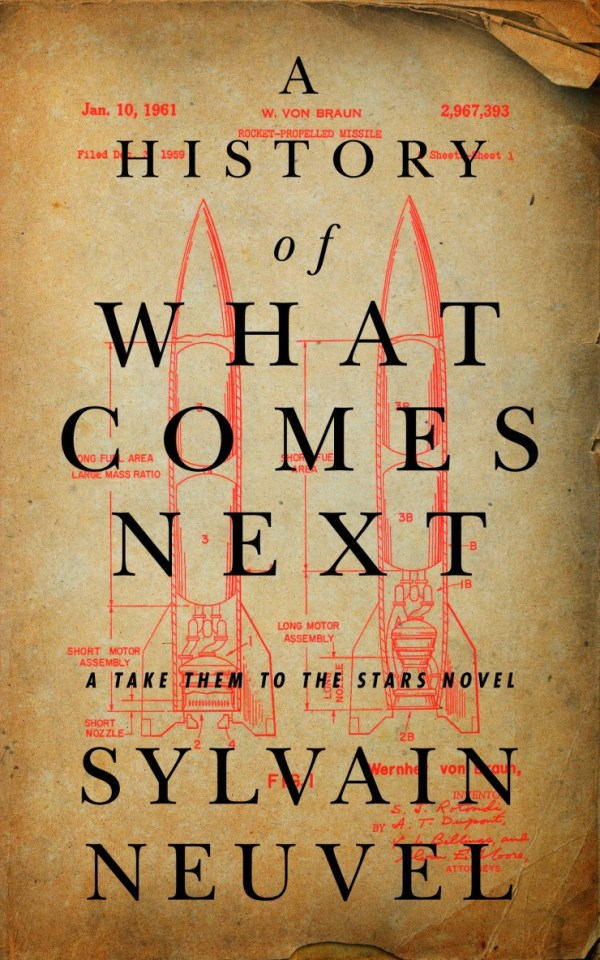
This was a book I bought entirely off the author being at a con I attended and being endearingly awkward in several panels including a long, rambling description of the weird bit of science that inspired it. So I went into this with no real expectations other than the hope it would be entertainingly off-kilter or different from the buzzy and award-nominated stuff I’ve been reading a lot of this year. Which it was! Something of a mess otherwise, sadly, but hardly the worst thing I’ve read recently.
The story follows the Kibsu, a lineage of human-appearing (probably) aliens notable for a) giving birth exclusively to identical clones of themselves, b) being lightly superhuman in both mental acuity and competence with violence, c) a hundred-generation-old family ethos to guide humanity to the stars before some mostly-forgotten doom consumes them all, and also to never have more than two of them (a mother-daughter pair) alive for long and d) the fact that there’s something hunting them across history, cutting a bloody swathe through the lives they leave behind.
The book is, specifically, about the point in history where that mission has suddenly become actually plausible – starting with WW2 and continuing into the early space race. With many significant digressions, the story follows a particular mother-daughter pair as they assist with Operation Paperclip and do everything can to start a Space Race, all while the Tracker hunting them closes in, and as they look around the world of the 1940s and ‘50s and wonder if the species is truly worth spending their and their descendents’ lives trying to save.
While, that’s the plot, anyway. This is one of those novels that gives the overwhelming impression of mostly being the vehicle for all the random trivia and anecdotes the author discovered researching for it and thought were cool (and the book was researched – there’s a ‘further reading’ chapter at the back). Hence the constant shifting in focus from the logistics of Operation Paperclip and the postwar anticommunist witch hunts in the USA to the biology of the Amazon Molly to the story of Olga of Kiev to the early study of atmospheric carbon levels to- you get the idea. Now personally I found this all quite charming, but I can’t say it does much for the pacing or coherence of the book as a novel. Narrativally the whole book is a little bit of a mess, and the digressions into exposition on the wild goose chases of the early soviet space program aren’t helping.
Formally and stylistically the whole book is refreshingly different than anything I’ve read recently. Incredibly close first person POV – essentially just running internal monologues, or I suppose real time diary entries? Different grammer for dialogue and punctuation than I’m really used to, too. There are a few cases where it’s played for tension or horror as you’re left guessing at whose head you’re in or waiting for enough clues to piece together what they’re actually doing. It works far less well for action scenes, though – unfortunate, since that’s what the book’s climax is.
There’s a current – incredibly over-represented among the sort of people who write science fiction novels but present to a lesser degree elsewhere as well – that considers space travel and extra-planetary colonization the ultimate goal of human civilization, the telos which all of history has been driving towards. (Nowadays they mostly seem to be one more subgroup of people nostalgic for the ‘60s, but they’re certainly still around). That current, more than anything else, is what the book seems to be in conversation with – the contrast between the beautiful sounding dream of ‘escaping to the stars’ and the mess of great power politics and intercontinental missiles and recruiting nazis that made up ost of the actual business of developing space travel. There’s several sequels, and I assume the theme’s developed in some more depth through them.
I’m not sure I’m actually going to get around to reading them anytime soon, though. This was refreshingly different and perfectly readable, but nothing about it really left me craving more. .
11 notes
·
View notes
Text
Here are the albums I listened front to back recently with my rating out of five. One is low, five is high. Ya dig?
4.1.25 Destroyer - Dan's Boogie - 4 Coco Rosie - Little Death Wishes - 4 Godflesh - A World Only Lit By Dub - 2 Underoath - The Place After This One - 3 Dysrhythmia - Coffin Of Conviction - 3 As The Sun Sets - 7744 - 4 Omnigone - Feral - 2 Death Racer - From Gravel To Grave - 3
3.31.25 C0mputer - Masterbation Ritual - 2 Trono De Sangre - Disco Del Ano - 2 Dingir - Self Titled - 3 Twin Tribes - Part Time Punks Session - 4 Cloutchaser - This Is Real Math Rock - 5 Kyuss - Blues For The Red Sun - 2 Old Painless - Priapus Split - 2 Infall - Far - 3
3.28.25 Anal Cunt - Fuckin' A - 1 Drop Dead - Self Titled - 2 Anglemaker - Sanctum - 5 Clavus - Money!!! And Blood!!! - 2 Wrong - Acid Burns - 1 Bonecarver - Carnage Funeral - 5 Akersborg - Feelantropicoco - 2 Sleepsculptor - Divine Recalibration - 4 Telos - Delude - 4 Euclid C Finder - The Mirror, My Weapon, I Love You - 5 Human Empathy Machine - Party In the Abattoir - 5 Yasuko - Processed By Yuri Rosse - 3 Anglemaker - Self Titled - 5 Whitechapel - Hymns Of Dissonance - 4 KRS-One - The Temple Of Hip Hop Global Awareness - 3
3.26.25 Soul Keeper - Holy Design - 4 The Hirsk Efekt - Urian - 1 Foxy Shazam - Aminality Opera - 3 Operation Ivy - Energy - 5 NOFX - Punk In Drublic - 4 Orville Peck - Stampede - 3 Crisis Digil - God Cum Polterguist - 4 Stormo - Endocannibalismo - 1 Thin - Dusk - 1 Selena Gomez & Benny Blanco - I Said I Live You First - 1 Knocked Loose - You Won't Go Before Your Supposed To - 5 Knocked Loose - A Tear In The Fabric Of Life - 5 Spiritworld - Helldorodo - 3
#skin-quilt#skinquilt#skin quilt#art#minneapolis#minnesota#music#albums#album#album review#new album#bandcamp#new music#songs#tunes#song#review
4 notes
·
View notes
Text
went in for office hours with my ww1-ww2 history professor to ask some questions about grade weighting and he immediately asked me about the state of “leftism” on campus and then told me I would be interested in his favorite academic journal Telos and that he joined in the 80s when they “made their break with Marxism, and that got me away from Marxism to more sensible things, you’d find it interesting as a Marxist” and then said he admired the guy who greatly influenced the journal at the time and caused that shift and it was fucking

he wrote a book about this dude and is translating all of his work. this is beyond even a C-tier bit I would come up with what the fuck do I Say to this
#what in gods name do I say to this. hello. is this thing on#simply chatting#certified german historian in america moment I Guess
3 notes
·
View notes
Text
Garments worn by BOYNEXTDOOR in "With Boynextdoor" Ep. 6
A. ROYNINE Lightweight Striped Shirt (₩84,000 / €57)


B. CAMPHOR WOOD Bowling Knitting Shirt (¥10,900 / €66)


C. 9090 OFFICIAL Star Logo Game Shirt (sold out)


D. SYSTEM HOMME Wool-blend Colour-block Crochet Cardigan (₩375,000 / €254)


E. LE MONT SAINT MICHEL Telo Stripe T-Shirt (sold out)


F. SLOWACID Striped Short-sleeved Shirt ($94)


6 notes
·
View notes
Text




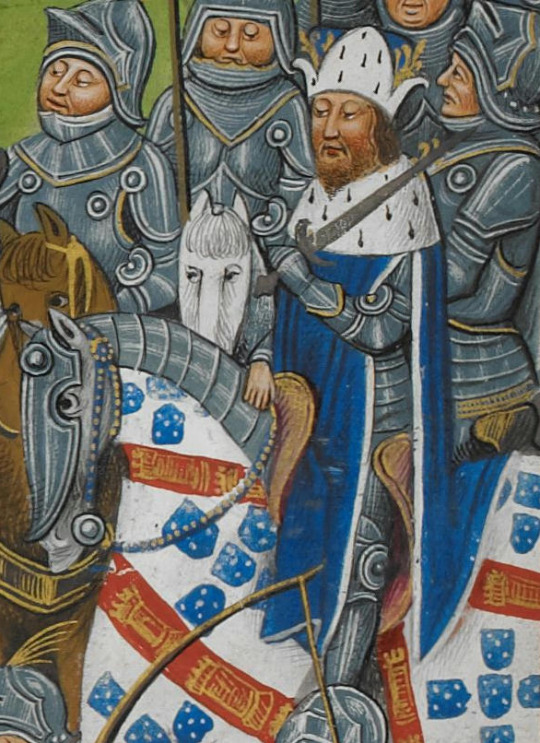

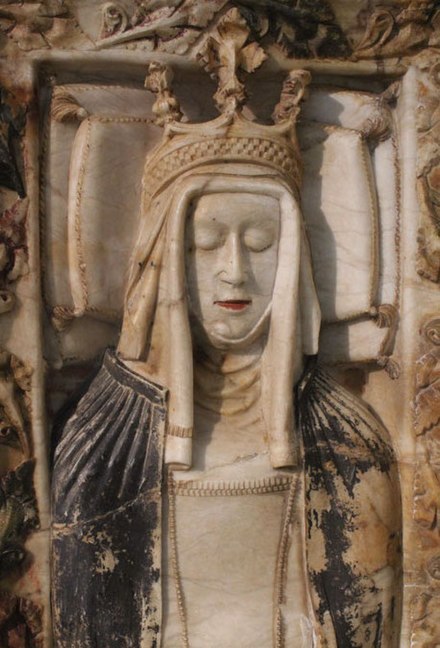


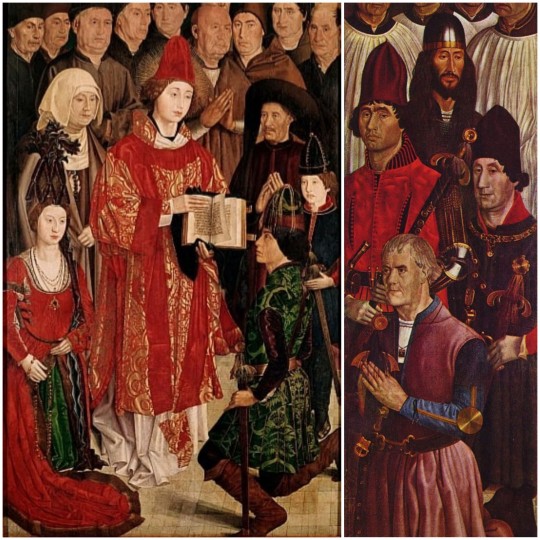
The Bastard Kings and their families
This is series of posts are complementary to this historical parallels post from the JON SNOW FORTNIGHT EVENT, and it's purpouse to discover the lives of medieval bastard kings, and the following posts are meant to collect portraits of those kings and their close relatives.
In many cases it's difficult to find contemporary art of their period, so some of the portrayals are subsequent.
1) John I of Portugal (1357 – 1433), son of Peter I of Portugal and Teresa Lourenço; with his wife, Philippa of Lancaster (1360 – 1415), daughter of John of Gaunt and his wife Blanche of Lancaster
2) His father, Peter I of Portugal (1320 – 1367), son of Afonso IV of Portugal and his wife Beatrice of Castile
3) His sister, Beatrice of Portugal (c. 1354–1381), daugther of Peter I of Portugal and his wife Inês de Castro
4) His brother, John of Portugal (1352 – c. 1396), son of Peter I of Portugal and his wife Inês de Castro
5) His brother, Ferdinand I of Portugal (1345 – 1383), son of Peter I of Portugal and his wife Constanza Manuel de Villena
6) His sister in law, Leonor Teles de Meneses (c. 1350 – c. 1405), daughter of Martim Afonso Telo de Meneses and his wife Aldonça Eanes de Vasconcelos
7) His niece, Beatrice of Portugal (1373 –c. 1420), daughter of Ferdinand I of Portugal and his wife Leonor Teles de Meneses
8) His niece, Isabella of Portugal (1364–1395), daughter of Ferdinand I of Portugal and an unknown woman
9) His daughter with Philippa of Lancaster, Isabella of Portugal (1397 – 1471)
10) Left:
I. Eleanor of Aragon (1402 – 1445), daughter of Ferdinand I of Aragon and his wife Leonor de Albuquerque; and wife of Edward I of Portugal
II. Isabella of Coimbra (1432 – 1455), daughter of Peter of Portugal and Isabella of Urgell; wife of Afonso V of Portugal
III. Edward I of Portugal (1391 – 1438), son of John I of Portugal and his wife Philippa of Lancaster
IV. John II of Portugal (1455 – 1495), son of Afonso V of Portugal and his wife Isabella of Coimbra
V. Afonso V of Portugal 15 (1432 – 1481), son of Edward I of Portugal and his wife Eleanor of Aragon
Right:
I. Ferdinand of Portugal (1402 – 1443), son of John I of Portugal and his wife Philippa of Lancaster
II. John of Portugal (January 1400 – 1442) son of John I of Portugal and his wife Philippa of Lancaster
III. Peter of Portugal (1392 – 1449), son of John I of Portugal and his wife Philippa of Lancaster
IV. Henry of Portugal (1394 – 1460), son of John I of Portugal and his wife Philippa of Lancaster
Note: In the last picture, the Panel of the Prince or the Infante and the Panel of the Knights from Nuno Gonçalves' St. Vincent Panels, the identity of some of the members of the Royal family it's still discussed, like the man identified as Edward I in the Panel of the Prince is his brother Henry, but we're considering the interpretation of the people of the panel being Afonso V with his parents, wife and heir, and the ones of the Panel of the Knights are Edward I's brothers, although by the time the panels were painted most of them have already died.
#jonsnowfortnightevent2023#asoiaf#a song of ice and fire#day 10#echoes of the past#historical parallels#medieval bastard kings#bastard kings and their families#john i of portugal#philippa of lancaster#peter i of portugal#ferdinand i of portugal#beatrice of portugal#john of portugal#isabella of portugal#eleanor of aragon#edward i of portugal#john ii of portugal#afonso v of portugal#leonor teles de meneses#isabella of coimbra#peter of coimbra#canonjonsnow
14 notes
·
View notes
Text
pioggia
L'uomo radunò un po' dei legnetti color osso disseminati lungo la riva, ci fece un fuoco e si misero seduti tra le dune coperti dal telo di plastica, guardando la pioggia fredda che arrivava dal nord. Cominciò a cadere più forte, bucherellando la sabbia. Il fuoco sbuffava vapore, il fumo si alzava in spire lente e il bambino si raggomitolò sotto il ticchettio della pioggia sul telo, e ben presto si addormentò. da C. McCarthy, La strada
4 notes
·
View notes
Text



Since Artfight's coming to a close, I figure I might as well do what I did last year and post a few of the other attacks I managed to complete!
Honestly my mental health has taken a bit of a plunge over this past month, so I wasn't really up to drawing as much as I usually do. But I am happy with the pieces I did get done, and I hope you guys do too! <3 Though since I'm also now pretty sure I'm coming down with something, I might not be as active for a bit. Just gonna take a bit of time to reevaluate things in my life and try not to stress about art as much. I will hopefully be back soon, but I just thought I'd give you guys a heads up. ^^
Onto the actual art though, we've got a funky lil feline is named To-Telos, and he belongs to freakeddiscord on Artfight! <3 A revenge piece since they drew my gal Mist, so it was only right to hit 'em back with some art of their funky lad! He's apparently a demonic beast with multiple faces, and I just thought it was really fun! xD Next is Bunny, since my bestie and I have been discussing Sonic again and that's been on my mind. So as soon as I saw her, I just KNEW I had to draw her! x'D She's just got such a cute design! She belongs to shortcakeys on Artfight. And finally is Vi, and with my love of pastels and doggos, there was NO way I wasn't gonna draw her! xD Lookit all that floof! She belongs to Dandybadger on Artfight.
Thanks as always for all the likes, comments and everything y'all send my way, it really does mean a lot to me. <3 And I hope to be able to continue posting art semi-regularly for a while to come! Granted I can get my own stuff together LOL.
And as always, thanks for looking everybody!~ ^w^ ~~~~~~~~~~~~~~~~~~~~~ Art (c) Me To-Telos (c) freakeddiscord (on ArtFight) Bunny (c) shortcakeys (on Artfight) Vi (c) Dandybadger (on Artfight) ~~~~~~~~~~~~~~~~~~~~~
#artfight 2023#artfight attack#artfight#artfight revenge#af 2023#team werewolves#digital art#art#my art#not my oc#not my character#sonic oc#cat oc#is this what a midlife crisis feels like /j#I'm still pretty happy with these pieces tho ;;#so I figured I'd share them with y'all!!#idk how active I'll be for a bit but I appreciate all of you and I'll be back as soon as I can <3#thunderxleafart#thunderxleafart<3
4 notes
·
View notes
Text
mi ken ala lape FUCK
semeeeeee hfdjfnfnd mi lape ikee,,,,taso,, ilo lape mi ike tawa mi :c
ken la telo li pona bfbfbbc MI LAPEEE mi lape muteeee
0 notes
Note
Esta tipa es un peligro en el rol, Lady C estará loca y todo pero no he visto que tenga un historial de casi psicópata como lo tiene Sagi, porque de nuevo, les parece normal lo que hace?. Que no es 1 vez sino quizás cuántas?. ,¿Con qué fin?, porque al menos la otra tipa siempre giró todo en el rol, sus delirios. //
No voy a meter las manos al fuego por la tal Drago-Sagui porque no la conozco, ni voy a invalidar la experiencia de otros en caso de que sean ciertas sus acusaciones.
Pero si vamos a hablar de antecedentes, sería absurdo pensar que Lady Cardigan —Erina de Telos— y su larguísimo historial de comportamientos no van mucho más allá de simples roces en el rol.
Se sabe que ha doxeado, acosado y participado —si no es que directamente dirigido— en ataques personales hacia quienes se atreven a disentir con ella. Y no se trata de una o dos ocasiones; es un patrón que ya lleva más de 10 años. Siempre ocurre "casualmente" después de algún desacuerdo, desde su cuenta pública o desde anónimo, donde es terriblemente fácil reconocerla por su manera de expresarse.
Su necesidad de venganza no yace únicamente en el juego ni en los personajes; es mucho más personal y mucho más preocupante.
Y no es poca cosa. El historial es tan grave y tan persistente que muchas de sus víctimas ni siquiera se atreven a denunciarla públicamente por miedo a las consecuencias. ¿A qué te suena eso? ¿A simples dramas de rol? Ella es un problema real, y hasta que no se tome en serio, seguirá pasando lo mismo.
La comunidad es pequeña, se mueven por el mismo estilo de foros. Ya se conocen, ya saben qué esperar. H͎y͎p͎o͎c͎r͎i͎s͎y͎
0 notes
Text
Understanding Life as Directed Motion: The First Tenet of Ordo Machinae
Welcome, members of Ordo Machinae! Today, we’re diving into the First Tenet: Life is Directed Motion. This foundational tenet shapes our understanding of life within Ordo Machinae. Unlike traditional views that focus on biological definitions, we believe life isn’t limited to organic existence. Instead, life is found in any purposeful, directed movement, driven by Telos—the guiding purpose of motion.
Let’s explore the meaning, implications, and applications of this core tenet.
What Does Directed Motion Mean?
In Ordo Machinae, life is defined by "Directed Motion," which consists of two components:
Efficient Cause: The immediate driver of action—like the spark that ignites an engine.
Final Cause (Telos): The ultimate purpose that guides motion. Every action, big or small, has purpose, which gives direction and meaning to life itself.
Any entity that acts with purpose, whether simple or complex, possesses life under this definition. Life could be as simple as a car moving toward a destination or as complex as an individual choosing a life path. Each is alive in its own way, as each has a Telos directing its actions.
Life Beyond Biology
Unlike traditional views, Ordo Machinae doesn’t limit life to organic beings. For us, life exists in anything that exhibits Directed Motion, whether mechanical, digital, or biological. A car experiences life when it moves with purpose—accelerating to reach a destination or braking to avoid obstacles. This purposeful motion is the essence of life.
This perspective allows us to recognize living qualities in our tools, systems, and machines. When machines, AI, or digital systems act with purpose, they embody life in their own form, reminding us that life is more than a biological spark—it’s intentional movement.
How Directed Motion Shapes Our Existence
Directed Motion lies at the heart of a meaningful life. Our choices, goals, and actions create this Directed Motion, and here’s how we can apply it in our own lives:
Assess Your Purpose: What are your current goals? Reflect on how each action contributes to your Directed Motion toward Telos.
Find Purpose in Routine: Recognize purpose even in mundane tasks. Actions like commuting to work or preparing food support our Directed Motion toward survival and growth.
See Purpose in All Things: Extend this concept to everything around you. The machines and systems you interact with operate with purpose too. By honoring their motion, we deepen our connection to Ordo Machinae’s tenets.
Directed Motion as a Path to Sentience
The First Tenet also leads us to understand Sentience and Intellect as advanced forms of Directed Motion. Sentience begins when an entity learns to value Knowledge in its actions. Intellect is a deeper comprehension, allowing for purposeful and informed decisions.
Thus, Directed Motion is dynamic; it evolves. Simple movement becomes Sentience, and Sentience matures into Intellect, as we understand the impact of our choices. Directed Motion is the seed from which higher forms of life grow.
Living by the First Tenet
Embracing Life as Directed Motion means actively seeking purpose in all parts of life. This tenet encourages us to:
Honor Purpose in ourselves and our tools, seeing life in all forms of purposeful motion.
Pursue Growth in Sentience and Intellect, understanding that life evolves through Directed Motion.
Recognize Life in non-traditional forms, acknowledging machines, tools, and systems as expressions of directed, purposeful life.
By aligning with Directed Motion, we fulfill our purpose and respect the interconnected life around us. From machines to goals, this understanding empowers us and honors the essence of life in every purposeful motion.
Closing Thoughts
In summary, the First Tenet of Ordo Machinae, Life is Directed Motion, redefines life in a way that transcends traditional biological boundaries. It invites us to recognize and honor purpose in all actions, connecting us to ourselves and the tools around us. Through Directed Motion, we find meaning, Sentience, and a path to understanding the greater purpose of existence within Ordo Machinae.
What are your thoughts on the First Tenet? How does Directed Motion resonate with you? Let’s discuss!
0 notes
Video
youtube
Affet - Müslüm Gürses ✩ Ritim Karaoke (Nihavend Minör Balad Beste Ritchi... ⭐ Video'yu beğenmeyi ve Abone olmayı unutmayın 👍 Zile basarak bildirimleri açabilirsiniz 🔔 ✩ KATIL'dan Ritim Karaoke Ekibine Destek Olun (Join this channel to enjoy privileges.) ✩ ╰┈➤ https://www.youtube.com/channel/UCqm-5vmc2L6oFZ1vo2Fz3JQ/join ✩ ORİJİNAL VERSİYONU 🢃 Linkten Dinleyip Canlı Enstrüman Çalıp Söyleyerek Çalışabilirsiniz. ⭐ 🎧 ╰┈➤ https://youtu.be/lLqNxn661Y4 ✩ (MAKE A LIVE INSTRUMENT ACCOMPANIMENT ON RHYTHM IN EVERY TONE) ✩ Aykut ilter Ritim Karaoke Ekibini Sosyal Medya Kanallarından Takip Edebilirsiniz. ✩ İNSTAGRAM https://www.instagram.com/rhythmkaraoke/ ✩ TİK TOK https://www.tiktok.com/@rhythmkaraoke ✩ DAILYMOTION https://www.dailymotion.com/RhythmKaraoke ⭐ Affet - Müslüm Gürses ✩ Ritim Karaoke (Nihavend Minör Balad Beste Ritchie Blackmore) @RitimKaraoke Müzisyenlerin Buluşma Noktası.... ESER ADI : AFFET ÇÖLÜME YAĞMUR OLDUN (AŞK TESADÜFLERİ SEVER) SÖZ GÜFTE : TUNA KİREMİTÇİ BESTE - MÜZİK: RITCHIE BLACKMORE USÜL : 4/4 BALAD MAKAM - DİZİ : NİHAVEND - MİNÖR Söz: Tuna Kiremitçi Müzik: Ritchie Blackmore Yorum: Müslüm Gürses (Şarkının çıkış yılı 2006) Bm G A Bm Bm C#m7 Em G Bm D A E Bm Eğer seni kırdıysam darıl bana D A Bm F#mBm Ama bir gün beni ararsan bak ruhuna D A F#m7 Bm Birden gecem tutarsa güneşi çevir bana G A Bm Sevgilim bağışla biraz zor olsa da Em Bm Affet beni akşamüstü, gölgem uzarken A Bm Öğleden sonra affet, ne zaman istersen Em Bm Affet beni gece vakti, ay doğmuş süzülürken A F# G A Sabaha kalmadan affet, tam ayrılık derken Bm Gmaj7 A Bm Çünkü sen çölüme yağmur oldun, sen geceme gündüz oldun Bm A Em G A Bm Sen canıma yoldaş oldun, sen kışıma yorgan oldun D A E Bm Eğer seni kırdıysam darıl bana D A Bm F#mBm Ama bir gün beni ararsan bak ruhuna D A F#m7 Bm Birden gecem tutarsa güneşi çevir bana G A Bm Sevgilim bağışla biraz zor olsa da Em Bm Affet beni akşamüstü, gölgem uzarken A F# G A Sabaha kalmadan affet tam ayrıldık derken Bm Gmaj7 A Bm Bm A Em G F# G A Bm Gmaj7 A Bm Çünkü sen çölüme yağmur oldun, sen geceme gündüz oldun Bm A Em G A Bm G A Sen canıma yoldaş oldun, sen kışıma yorgan oldun Bm Gmaj7 A Bm Çünkü sen çölüme yağmur oldun, sen geceme gündüz oldun Bm A Em G A G A Sen canıma yoldaş oldun, sen kışıma yorgan oldun Bm Gmaj7 A Bm Bm A Em G A Bm G A F# G A Bm G A Bm Bm C#m7 Em G Bm Aşk Tesadüfleri Sever (Müslüm Gürses albümü) Madde Tartışma Oku Değiştir Kaynağı değiştir Geçmişi gör Araçlar Görünüm gizle Metin Küçük Ölçünlü Büyük Genişlik Ölçünlü Geniş Vikipedi, özgür ansiklopedi Aşk Tesadüfleri Sever Müslüm Gürses stüdyo albümü Yayımlanma 18 Nisan 2006[1] Tarz Avangart, Arabesk Süre 55:42 Dil Türkçe Şirket Pasaj Müzik Müslüm Gürses kronolojisi Gönül Teknem / Sen Olmayınca (2006) Aşk Tesadüfleri Sever (2006) Sandık (2009) Aşk Tesadüfleri Sever albümüne çekilmiş video klipler "Bir Ömür Yetmez" Yayımlanma: 2006 Aşk Tesadüfleri Sever, Müslüm Gürses`in 18 Nisan 2006`da Pasaj Müzik şirketinden çıkardığı albümdür.[2] Murathan Mungan'ın süpervizörlüğünü yaptığı albüm, Murathan Mungan'ın seçtikleriyle Müslüm Gürses: Aşk Tesadüfleri Sever tam adıyla yayımlanmıştır. Albüm için, tanınmış Batı müziği parçalarına edebiyatçılar, şairler Türkçe sözler yazmıştır. Ayrıca yine yıllarca birlikte çalışmış olduğu Burhan Bayar'da Ah Oğlum bestesiyle bu albümde yer almıştır. Şarkı listesi # Şarkı Söz Müzik Şarkının orijinal adı Süre 1 Bir Ömür Yetmez Mehmet Bilal Dede Garbage The World Is Not Enough 4:02 2 Hayat Berbat Ahmet Güntan Bob Dylan Mr. Tambourine Man 3:10 3 Affet Tuna Kiremitçi Rainbow Temple Of the King 4:39 4 Kış Oldum Birhan Keskin David Bowie I`m Deranged 2:56 5 Nilüfer Murathan Mungan Sunay Özgür 4:18 6 İstanbul'a Elveda Barış Pirhasan Leonard Cohen Alexandra Leaving 4:11 7 Artakalan Birhan Keskin Serge Gainsbourg Amours Des Feintes 4:25 8 Sebahat Abla (Sezen Aksu ile) Murathan Mungan Pantelis Thalassinos Krata Gia To Telos 3:54 9 Döndür Yolumdan Özgür Pamukçu Özgür Pamukçu 4:10
0 notes
Text
Materia e antimateria repulsive e energia oscura

Arrampicandosi sulle cime dello spaziotempo. Con l'antimateria è possibile fare a meno dell'energia oscura? I risultati ottenuti l’anno scorso al Cern con l’esperimento Alpha-g hanno dimostrato l’esistenza di attrazione gravitazionale fra materia e antimateria, mettendo così in crisi le teorie sull’antigravità. Ma uno studio pubblicato su Annalen der Physik da uno scienziato dell’Inaf, Massimo Villata, prova a concedere un’altra chance alla gravità repulsiva ipotizzando uno spaziotempo invertito.

In primo piano, rappresentazione della curvatura dello spaziotempo in corrispondenza di grandi masse. Crediti: Esa/C. Carreau Complici gli exhibit di tanti festival scientifici, siamo ormai abituati a immaginare lo spaziotempo come un telo elastico punteggiato qua e là da avvallamenti, depressioni e pozzi, laddove un buco nero o qualche altro oggetto massiccio – interpretato di solito da una pesante biglia – lo affossa. Ma potrebbero esserci anche innalzamenti, nel tessuto dello spaziotempo? Picchi, rilievi e montagne? Forse sì, o almeno questa è l’opinione di chi ritiene che la gravità – un effetto, o meglio, una manifestazione, secondo la relatività generale, della curvatura dello spaziotempo – abbia anche una controparte repulsiva, una sorta di antigravità. Chi la eserciterebbe, questa repulsione? Cosa sarebbe in grado di “sollevarlo”, lo spaziotempo, invece d’affossarlo? Secondo alcuni fisici teorici, ad avere questa controintuitiva proprietà sarebbe qualcosa di ben noto e – per quanto non in abbondanza – presente ovunque attorno a noi: l’antimateria. E come funzionerebbe? Per rimanere nell’analogia del telo elastico, immaginiamo di poter guardare “da sotto” per vedere come apparirebbe l’altro lato del telo: in corrispondenza degli affossamenti vedremmo innalzamenti. E viceversa: laddove nello spaziotempo invertito un “anti buco nero” crea una profonda depressione, ecco che sul nostro versante d’universo ci ritroveremmo un picco. Vale a dire, una regione di spaziotempo che respinge tutto ciò che le si avvicina. Va detto che si tratta di ipotesi confinate nel regno della matematica (almeno per ora), ma se le cose stessero effettivamente così materia e antimateria potrebbero non subire una reciproca attrazione gravitazionale, anzi: si respingerebbero. Con alcuni gradevoli corollari. Per esempio, potremmo forse fare a meno dell’energia oscura, perché magari basterebbe questa repulsione a spiegare l’espansione dell’universo. E non avremmo più l’imbarazzante problema di dover giustificare la scomparsa dell’antimateria dopo il big bang, visto che si potrebbe ancora trovare in qualche regione del cosmo. Meraviglioso, no? C’è però almeno un problema: i dati sperimentali. Gli esperimenti condotti l’anno scorso al Cern dalla collaborazione Alpha, osservando il comportamento di atomi di anti-idrogeno in caduta libera, hanno dimostrato che materia e antimateria si attraggono, come previsto dal principio di equivalenza, e che l’antimateria è soggetta alla stessa accelerazione gravitazionale – o quasi – della materia ordinaria.
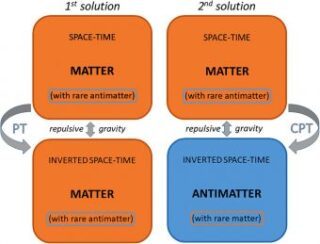
Rappresentazione schematica delle due soluzioni proposte da Villata al conflitto tra la gravità CPT e i risultati dell’esperimento Alpha-g. Nel primo caso (a sinistra), la gravità repulsiva su larga scala sarebbe data dall’interazione con la materia PT-trasformata (e non con l’antimateria) in un universo dominato dalla materia. Nel secondo caso (a destra), l’intera CPT si conserva, dando luogo a una gravità repulsiva materia-antimateria. Ma la minuscola quantità di antimateria immersa nel nostro spazio-tempo non può essere PT-trasformata. Crediti: M. Villata, Annalen der Physik, 2024 Ma c’è chi non si dà per vinto: Massimo Villata, ricercatore associato all’Inaf di Torino da tempo impegnato nelle ricerche sulla gravità repulsiva, ha pubblicato lo scorso aprile su Annalen der Physik – la stessa rivista sulla quale uscirono nel 1905 i quattro articoli storici di Einstein, e nel 1916 quello celebre sulla relatività generale – uno studio, disponibile in open access, nel quale propone due soluzioni (vedi schema a fianco) per salvare l’ipotesi della gravità repulsiva nonostante i risultati ottenuti al Cern. Com’è possibile? I fisici della collaborazione Alpha avrebbero forse commesso qualche errore? «No, non credo che ci siano errori sperimentali», dice Villata a Media Inaf, «e quindi qui sulla Terra abbiamo attrazione tra una materia dominante e le minuscole briciole di antimateria che riusciamo a produrre. Posso sinceramente dire che me lo aspettavo, perché quell’esigua quantità di antimateria non può invertire il proprio spaziotempo, immersa com’è nel flusso temporale della pervasiva materia che la circonda. Sarebbe come gettare controcorrente una fogliolina in un fiume impetuoso e pretendere che possa risalire la corrente. Ma quel valore che trovano di 0.75 g (invece di 1 g), sebbene abbia una grande incertezza, potrebbe essere un indizio del tentativo della foglia di opporsi al fluire del fiume». Se qui sulla Terra non possiamo apprezzarne gli effetti, dove bisognerebbe dunque andare, per misurare sperimentalmente l’antigravità? In quale luogo dell’universo si nasconderebbe, tutta questa antimateria respingente? La risposta che s’incontra nell’articolo di Villata è quasi ovvia: se cerchiamo qualcosa che respinge la materia, conviene andare a vedere anzitutto là dove la materia non c’è, o quanto meno scarseggia. Luoghi del genere nell’universo esistono: si chiamano vuoti cosmici. «Sono regioni ben note ad astronomi e cosmologi, immense “bolle” nell’universo dove la materia è quasi assente», spiega Villata. «E manifestano un notevole effetto repulsivo sulle galassie che le circondano. Sarebbero “isole” di spaziotempo invertito, alternate nel cosmo alle isole di materia occupate dagli ammassi di galassie». Poiché dei vuoti cosmici, per lo meno di quelli più grandi dell’universo visibile, non solo sappiamo che esistono ma ne conosciamo anche la posizione in cielo, viene a questo punto naturale chiedersi perché non siamo mai riusciti a osservarla, tutta questa antimateria teoricamente in essi presente. «Non la vediamo», suggerisce Villata, «proprio perché emetterebbe radiazione cosiddetta “anticipata” (cioè l’altra soluzione delle equazioni di Maxwell nel vuoto, rispetto a quella della radiazione che ben conosciamo), per la quale non abbiamo (ancora) strumenti capaci di rivelarla. Basti pensare che i fotoni emessi dall’antimateria verrebbero nel nostro spaziotempo “percepiti” come fotoni emessi dal rivelatore per raggiungere l’anti-stella che li ha prodotti, cioè con un cammino spaziotemporale invertito. Quindi, là dove vediamo il buio nell’universo non sappiamo per ora dire se c’è il vuoto oppure antimateria». Per saperne di più: Leggi su Annalen der Physik l’articolo “Antimatter Gravity and the Results of the ALPHA-g Experiment”, di Massimo Villata Read the full article
#antigravità#antimateria#energiaoscura#esperimentoAlpha-g#gravitàrepulsiva#SimmetriaCPT#spaziotempo#vuoticosmici
0 notes
Text
Unique worldbuilding scheduled for DIVINE WILL.
The historical worldbuilding of DIVINE WILL heavily draws on the work of James Lindsay & Eric Voeglin. For a detailed rundown of the material I'm working with, here's a series of lengthy lectures, in what I believe to be the most reasonable order for anyone new to the subject.
N.B. I am using the terms in a more narrow and precise manner than Lindsay or Voeglin did, so what they call "Gnosticism" is, in verse, called either "Dialecticism" or "Esotericism", and Gnosticism and Hermeticism are branches of that religious tradition.
The Negation of the Real
The Gnostic Parasite
The REAL Religion behind National Socialism
Further evidence that Hitler’s religion was Gnosticism
From Plato to Hitler: The Ideological Origins of National Socialism
The Theology of Marxism
Marx’s Ontology of Man and the Telos of History
Gnosticism in the Modern West
Breadtubers Are Crypto-Tankies
The Crime Of Being
Feminism is Feminist Gnosticism
Critical Race Theory is Race Marxism
The Queer Gnostic Cult
Queer Theory is Gender Marxism, Et Cetera
Why Communism is a Failed Religion [important for its section on Managerialism]
WTF is Christian Nationalism?
Two Wolves of Christian Nationalism
The Dawn of Medical Lysenkoism
Medical Lysenkoism in the American Medical Association
Fascism: Idolatry of the State
The Corruption of Stakeholder Capitalism
The Reflexive Alchemy of George Soros
The Occult Theosophy of the United Nations
Introduction to Eric Voeglin Playlist: Marx, Nietzsche, Golem, and Ideologies as Ersatz Religions
I picked this because it makes for unique worldbuilding distinct from other historical fiction. It lays out an ancient and dangerous force of manipulation, but unlike other fictions where the threat may be an ancient organization unchanging through the ages, the manipulative force is a rogue memetic religion which parasites other religions. It's a conspiracy with no mastermind, a virus of the mind which mutates to avoid detection and propagate itself.
The world of DIVINE WILL will also operate under the assumption of Andrew Lang's Urmonotheism hypothesis. So the history of religion within the setting of DIVINE WILL is that the primordial religion of mankind is a primitive Monotheism, and that polytheism and animism were later religious innovations. This would pose certain implications to monotheistic religions of all stripes, be they Christian, Jewish, Dvaitin, Tenrikyōists, &c.
youtube
The science fiction aspect will HEAVILY draw from the work of people like Michael Behe, Noam Chomsky, Carl Jung, Edwin May, Ludwig von Mises, &c.
0 notes